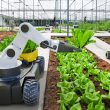When you think of NASA, images of Apollo 11 and Neil Armstrong’s space boots touching down on the moon usually come to mind. But as of 6:20 a.m. PST on Jan. 31, 2015, NASA’s focus now includes the soil beneath a different pair of boots—right here on Earth.
NASA’s first mission of the new year was deemed a success by officials, launching a Delta II rocket equipped with a soil moisture mapping satellite from Vandenberg Air Force Base in Lompoc, California.
The Soil Moisture Active Passive (SMAP) satellite will track moisture in the Earth’s top 5 centimeters of soil and help scientists track and forecast extreme weather events such as the movement of droughts. According to NASA administrator Charles Bolden, improving the tracking of water resources for agricultural purposes was a key component of this mission. “The launch of SMAP completes an ambitious 11-month period for NASA that has seen the launch of five new Earth-observing space missions to help us better understand our changing planet,” he said. “Scientists and policymakers will use SMAP data to track water movement around our planet and make more informed decisions in critical areas like agriculture and water resources.”
The SMAP satellite separated from the spacecraft within the first hour of launch en route to an operational orbit of 685.6 kilometers (426 miles), where it will orbit the earth every 2-3 days and provide the highest-resolution maps of soil moisture ever obtained from space.
Shortly after the launch, NASA officials confirmed that data from the mission will be made public via NASA’s SMAP website in coming weeks.
The $916 million mission, which was delayed twice because of high winds earlier in the week, is expected to run for at least three years.
According to NASA, measurements from SMAP will provide high-resolution global mapping of soil moisture and freeze/thaw state that will enable science and applications users to:
• Understand processes that link the terrestrial water, energy and carbon cycles.
• Estimate global water and energy fluxes at the land surface.
• Quantify net carbon flux in boreal landscapes.
• Enhance weather and climate forecast capability.
• Develop improved flood prediction and drought monitoring capability.
While the global data will allow scientists to better track drought patterns as well as the links between soil moisture and weather, the data isn’t expected to be detailed enough to provide insight into individual irrigation blocks or zones. So it’s doubtful SMAP will have a major effect on the day-to-day operations of farmers in the short-term.
SMAP uses a pair of microwave instruments to monitor down to the top 5 centimeters (2 inches) of soil. But the soil moisture only estimates down to 9 kilometers (6 miles), and covers the globe every 2-3 days, which Rosalie Murphy, of NASA’s Jet Propulsion Laboratory, points out “cannot show how soil moisture might vary within a single field, (but) it will give the most detailed maps yet made” from space.
To ensure accuracy, NASA officials said their scientists will go through an extensive process to calibrate the radiometer measurements to actual soil moisture measurements at pre-selected sites across the globe to assure the data is accurate across various soil types and landscapes.
Once calibrated, the SMAP measurements could help growers long-term by identifying the early signs of agricultural drought, which NASA notes: “will come into play because researchers forecast a threefold increase in drought frequency in many regions of the world by the end of the twenty-first century. History shows that a sustained drought can result in crop failure, deaths of livestock, and ultimately deaths of people. There is an economic impact as well. It is estimated that the 2012 drought in the Midwest led to harvest failures costing an estimated $30 billion.”
NASA officials added SMAP data could help improve crop productivity by measuring soil moisture and helping project production across multiple regions. That information could be used not only for agricultural purposes, but for targeting humanitarian food assistance programs. More accurate, long-term weather forecasts could also benefit growers who are uncertain about when to plant, water, fertilize and harvest their crops in the face of changing climates.
“If farmers of rain-fed crops know soil moisture, they can schedule their planting to maximize crop yield,” said Narendra Das, a water and carbon cycle scientist at NASA’s Jet Propulsion Laboratory in Pasadena. “SMAP can assist in predicting how dramatic drought will be, and then its data can help farmers plan their recovery from drought.”












